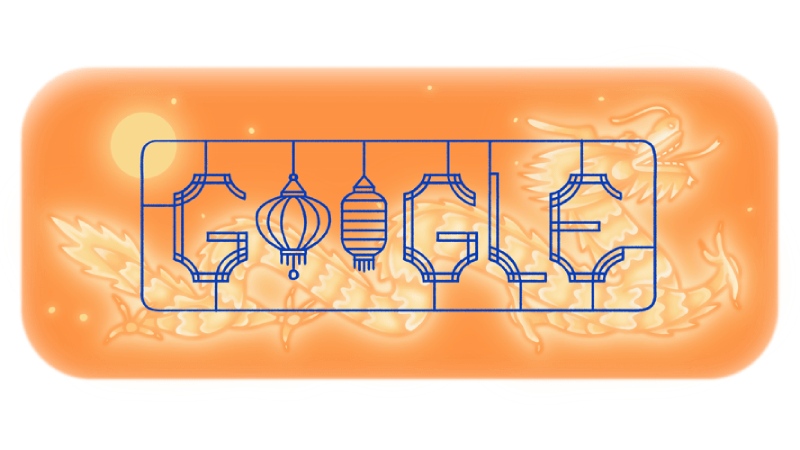Festivals & Events
Interesting Facts about Lantern Festival, a Traditional Chinese Shangyuan Festival

The year of the dragon is highlighted in the Lantern Festival 2024 Google Doodle. The Lantern Festival and the good fortune it brings are honored in this Doodle. People all over Asia light lanterns and let them float through the sky or across the water on this festival, which officially ends the Lunar New Year celebrations on the fifteenth day of the first lunar month. Happy Lantern Festival 2024!
The Lantern Festival (traditional Chinese: 元宵節; simplified Chinese: 元宵节; pinyin: Yuánxiāo jié) is a traditional Chinese festival that is celebrated during the full moon on the fifteenth day of the first month in the lunisolar Chinese calendar. It is also known as the Shangyuan Festival (traditional Chinese: 上元節; simplified Chinese: 上元节; pinyin: Shàngyuán jié). On the Gregorian calendar, it usually occurs in February or early March and is the last day of the traditional Chinese New Year celebrations. It developed into a festival of great importance as early as the Western Han dynasty (206 BC–AD 25).
Quick Facts
- Official name: Yuánxiāo jié (元宵節) / Shàngyuán jié (上元節)
- Observed by: Chinese
- Type: Cultural, Religious
- Significance: Marks the end of the Chinese New Year
- Observances:
- Flying of paper lanterns;
- Consumption of tangyuan
- Date: 15th day of the 1st lunisolar month
- Related to:
- Chotrul Duchen (in Tibet)
- Daeboreum (in Korea)
- Koshōgatsu (in Japan)
- Magha Puja (in Thailand, Sri Lanka, Myanmar, Cambodia and Laos)
- Tết Nguyên Tiêu (in Vietnam)
Interesting Facts about the Lantern Festival
- Children solve riddles on paper lanterns during the Lantern Festival (traditional Chinese: 猜燈謎; simplified Chinese: 猜灯谜; pinyin: cāidēngmí). Children go outside at night with lanterns. Only the emperor and noblemen had large, elaborate lanterns in the past; lanterns were generally quite simple back then. Lanterns nowadays are decorated with a plethora of intricate designs. For example, lanterns are now frequently fashioned like animals. The lanterns can represent the people acquiring new identities that they will let go of in a year and letting go of their old ones. Almost always, the lanterns are red, signifying good fortune.
- In the Chinese calendar, the festival is equivalent to an Uposatha day. It is not to be confused with the Mid-Autumn Festival, which is sometimes celebrated in places like Indonesia, Malaysia, and Singapore under the name “Lantern Festival”. In Western countries, lantern festivals have gained popularity as well. One example is the Water Lantern Festival, which takes place across several US locations.
- Only Asian countries—China, Japan, South Korea, and Singapore—have the Chinese Lantern Festival.
- According to the Chinese calendar, lanterns are lit during the Chinese Lantern Festival in the lunar month. Around the world, Chinatowns are now the usual places for people to celebrate the Lantern Festival.
- The event now only lasts for a week or two, but it used to take place around Chinese New Year and last for 15 days. This celebration differs greatly from its counterpart in the West in that it is typically held outside, whereas most carnivals take place indoors. These Chinese Lantern Festival celebrations were much larger in the past than they are now. This celebration differs greatly from its counterpart in the West in that it is typically held outside, whereas most carnivals take place indoors.
- A Chinese lantern is a circular lantern composed of paper and bamboo. Depending on what the lanterns are, who is making them, or who will be using them, the decorations on them represent different things. Common connotations include power, longevity, fertility, and protection from evil spirits. The Yuan Xiao Festival, also known as the Lantern Festival celebrations, in mainland China is the subject of numerous origin stories. These include the tales of the Jade Emperor, Emperor Ming, and numerous others. Most frequently seen hanging around are the red lanterns with lantern riddles. This lantern festival is observed on the fifteenth day of the first month of the year, by the Chinese lunar calendar.
- In the past, Buddhist monks were known to honor Buddha by lighting lanterns. Chinese Lantern Festival delicacies include sweet rice balls, tea eggs, peanut soup, and Kao Fu Fa. Lanterns are typically used to adorn homes to draw luck in the future. Lanterns are also used at this time to symbolize letting go of the past and welcoming the future. The city is further enhanced in beauty by the red lanterns.
- Around the world, numerous countries celebrate the cultural and artistic significance of the Chinese Lantern Festival. This lantern festival has its roots in ancient China, which was thousands of years ago.
- Many people now take advantage of the Lantern Festival as a chance to learn more about Chinese history and culture while having fun with fireworks displays and traditional singing and dancing performances. “What is its origin?” is a question that most people have frequently regarding the Chinese Lantern Festival. To honor the lantern festival celebrations, there is a festival featuring a dragon dance, Chinese lanterns, lantern riddles, and much more.
- The origins of this festival can be found in the prehistoric era when people first used fire to cook food and stay warm. As civilizations advanced through time, some lantern designs were created with glass spheres to accommodate candles. Eventually, oil lamps and other forms of crude lighting replaced these designs.
- The lanterns eventually ceased to serve as functional objects and were adopted by the Chinese people as a sign of respect and devotion. The origins of the Chinese Lantern Festival date back to the Han Dynasty, when two rival groups agreed to temporarily set aside their differences to celebrate together.
- Chinese culture as a whole embraced this practice after these parties began adorning their camps with a variety of vibrant lanterns. In addition, Emperor Wu of Han gave his subjects instructions to construct enormous paper lanterns so he could light them at night and indulge in his favorite activity of stargazing without being disturbed by daylight. It’s also said that he witnessed a monk illuminating lanterns as a sign of his love for Buddha.
- The Chinese Lantern Festival is said to have its roots in Taoism some. The luck god of Taoism is called Tangyuan. The fifteenth day of the first lunar month is his birthday. According to legend, Tangyuan’s followers organize a variety of events where they beg for blessings because they enjoy a wide range of activities. In ancient China, an ancient warrior named Lan Moon is said to have led a revolution against a despotic ruler.
- He was killed in the process of taking the city, and on this day the triumphant rebels honored his memory. Another legend surrounding the Chinese Lantern Festival claims that a town was cursed with eternal mourning by the Jade Emperor (You Di), who was incensed over the death of his goose. The people were told by a fairy to light lanterns on the night of destruction to ward off the mischievous figure.
- The Emperor was duped into believing that the city had already been set on fire by the city’s lights. Since the town’s residents were spared, they have continued to parade with vibrant lanterns as a way of showing their gratitude. Every time a festival is observed, the Chinese zodiac changes. The next year will be the tiger’s if this one is the cow’s.
- People now frequently celebrate the Lantern Festival in Chinatowns across the globe. The event now only lasts for a week or two, but it used to take place around Chinese New Year and last for 15 days. This celebration differs greatly from its counterpart in the West in that it is typically held outside, whereas most carnivals take place indoors.
- People frequently engage in a variety of activities, such as setting off firecrackers to ward off evil spirits, carrying vibrant lanterns through the streets and along canals, and taking in live performances of traditional dances and songs. Millions of tourists visit the Chinese Lantern Festival every year to witness this visual cultural oasis, which is extremely well-liked throughout Asia.
- The Lantern Festival offers a unique opportunity to learn more about this mysterious culture from many people who have visited, even though many people study China in school. It is not surprising that this celebration has become more and more well-known in recent years for all of these reasons.
- A whole week is devoted to celebrating it throughout Asia, primarily in China. This festival is marked by a variety of customs, such as the consumption of Yuan Xiao, which are sticky rice balls, the hanging of lanterns, and the release of sky lanterns. Eating Yuan Xiao with loved ones and taking in dragon or lion dances on Chinese New Year’s Eve is one way to take part in the festivities.
- Celebrated in several East Asian nations, the Chinese Lantern Festival is also called the Feast of Silk. This festival ushers at the end of the Lunar New Year while honoring the achievements of Buddha.
- This festival has been observed with a wide range of customs and traditions in China for over 2,000 years. On the evening before the full moon at the end of winter, which occurs in late February or early March, many people are familiar with the custom of floating lanterns into the water. Usually made of delicate paper lamps, these lanterns would have intricate designs with dragons (signifying power), pomegranates (representing fertility), peach blossoms (representing happiness), and bamboo (representing longevity) as decorations.
- In ancient times, people believed that doing this would guarantee a year of peace and prosperity, even though it is no longer practiced. Zongzi, or sticky rice wrapped in leaves and occasionally stuffed with eggs, meat, or vegetables, is another widely enjoyed Chinese Lantern Festival custom in China. Chinese lantern riddles are difficult for the general public to solve.
- Traditionally shaped like a pyramid, the rice dumplings represent a family reunion and are served with other foods that have symbolic meanings, like pomegranates (for fertility), oranges (for wealth), and “longevity” noodles (for long life). Although the specific ingredients may differ depending on the area, they nearly always include meat of some kind with sweet fillings, like red bean paste.
- Zongzi is made to demonstrate the host’s generosity, just like many other food customs during festivals, and it has been connected to festivities for almost 2,000 years. Numerous other Chinese Lantern Festival customs have been passed down through the ages in addition to zongzi. Chinese communities hold lantern fairs, temple celebrations, and dragon and lion dances to commemorate this spring festival that emphasizes the value of good fortune.
- During the dragon dances, a dragon costume—especially a golden dragon costume—is frequently seen. A round-shaped dragon dances while consuming rice dumplings and lighting lanterns. During this festival, a traditional dragon dance is presented, frequently accompanied by traditional drums and cymbals, as a means of requesting blessings from Buddha.
- It also represents the end of winter and the arrival of rain, which in the past was thought to bring wealth. 500–1,000 years ago, lion dances were performed at temples as a means of ensuring protection from evil spirits, according to Buddhist belief. Today, people still follow this custom in hopes of attracting luck and prosperity. Chinese folklore holds that consuming jiaozi on the full moon day brings good fortune and tranquility to one’s family for the coming year.
- Many families also eat zongzi during the festival because it is thought that eating them will enhance one’s health. During this time, a lot of people visit Buddhist temples to offer prayers for their deceased ancestors. This is supposed to increase one’s blessings from the Buddha himself and lessen sorrow and misfortune from loved ones. During the Chinese Lantern Festival, traditional incense sticks can be given to temples as a gift or as an offering.
- The Chinese Lantern Festival is observed in countries like China, Taiwan, Hong Kong, Macau, Singapore, Indonesia, and Malaysia that have sizable Chinese populations.
- This festival honors and celebrates the arrival of spring and coincides with Zhongyuan Jie, a significant Chinese holiday (also known as Yuanxiao Jie). Bamboo and paper are used to make the lanterns that we see during the celebration. Although they were made with actual fire for many years, they are now made with LED lights inside for safety reasons.
- While the celebration varies depending on the location, children typically make lanterns and light them during the festival. This festival is significant because it is a way for people to welcome spring, and the end of winter, and enjoy the holiday by spending the night with lanterns, which stand for optimism for a better future.
- The Chinese Lantern Festival is an occasion to commemorate the arrival of spring and to look forward to improved circumstances in the future. In addition, it commemorates the Chinese New Year, which occurs in early March or February.
- This festival’s significance is also observed differently throughout the country, demonstrating its diversity. However, the custom usually involves children crafting lanterns and lighting them.
- It’s commonly believed that when foreign dignitaries were welcomed to Chang’an during the Tang Dynasty, the festival expanded its international scope. Except those used by children, lanterns are typically taller than people and are made of a paper or cloth shell set on an iron or bamboo frame with translucent fuel-based lighting (mostly candles, though battery-powered electric lights are now common).
- Each lantern has a long cord that allows one person to hold it aloft; multiple people can pull larger floats. Children go out at night to gather fruit and candy from friends and neighbors during the lantern festival. The lanterns are available in a variety of designs and hues, including flowers, dragons, and rabbits. In addition, Yu Sheng, or raw fish salad, is traditionally consumed on this day worldwide as a sign of family reunions; distant relatives pledge to get together during this joyous season.
- China celebrates three major holidays: New Year’s Day, Tomb Sweeping Day (Qingming), and Winter Solstice, or “Dongzhi.” The Chinese Lantern Festival is one of these holidays. One of the Chinese festivals that is given more importance is the Lantern Festival. There is nothing that can describe the sight of Chinese lanterns at night during this lantern festival.
- In celebration of the start of a new year, lanterns are hung, and fireworks light up the sky to say goodbye to the past and welcome the present.
- It’s a season of optimism, joy, and best wishes for the upcoming year. The 15th day of the lunar month following the Chinese New Year marks the Chinese Lantern Festival, which represents the joy of spring and harvest season. Lanterns are erected at this festival to commemorate the abundance of the Lunar New Year and to get ready for a bountiful crop.
- China celebrates this festival nationwide. Despite having centuries-old roots, the lantern festival has spread around the world, with many nations, including Singapore and Hong Kong, participating and using neon lanterns to celebrate. Because there are so many varied legends about lions, seeing a lion dance performance can be extremely symbolic.
- In China, for example, the lion is frequently connected to Buddhism. Buddhist pagodas and temples may perform the important lion dance to ward off evil spirits and safeguard the hallowed locations. This also holds true for the dragon dance, whose symbols resemble Chinese lanterns. This festival is celebrated as a spring festival on the fifteenth day of the lunar calendar. People and monks from nearby temples light lanterns as part of lantern lighting, red lantern drawings, lantern riddles, and lantern fairs featuring dragon and lion dances.
- Throughout this spring festival, messages in the Chinese language are written on lanterns with various drawings that represent prosperity to come. The celebration is referred to as Yuan Xiao in southern China and Tangyuan in northern China. The lantern fair takes place in Chengdu, Sichuan Province, at the Chengdu Culture Park in southern China.
-

 Business3 weeks ago
Business3 weeks agoPrakash and Kamal Hinduja: Driving Social and Environmental Change
-
Education4 weeks ago
Fred DuVal: University Leadership as a Critical Resource for Climate Change Research and Life-Saving Solutions
-

 Cryptocurrency3 weeks ago
Cryptocurrency3 weeks agoDesigned For The Masses: How Akasha (AK1111) Is Unlocking Crypto For The Next Billion Users
-

 Health3 weeks ago
Health3 weeks agoThe Hinduja Brothers Commitment to Global Health: Empowering Communities Across Borders
-

 Cryptocurrency4 weeks ago
Cryptocurrency4 weeks agoNexaglobal & Future World Token (FWT): Could This Be the Next Big Crypto Investment of 2025?
-

 Startup2 weeks ago
Startup2 weeks agoCost-Saving Strategies Every Small Business Owner Should Know to Boost Efficiency
-

 Startup3 weeks ago
Startup3 weeks agoMatthew Denegre on the Art of Deal Sourcing: Finding the Right Investment Opportunities
-

 Health2 weeks ago
Health2 weeks agoSt. John’s Community Health Examines Innovations in Pharmacy Access

























